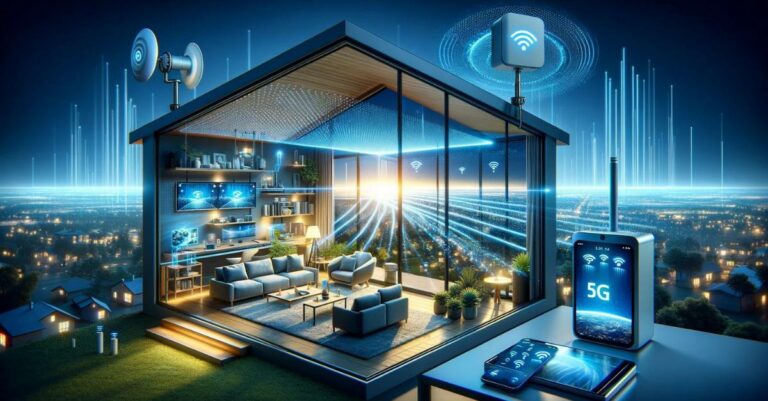Introduction to LiFi and Its Relevance to 5G Indoor Coverage
LiFi technology, standing for Light Fidelity, represents a transformative approach to wireless communication that uses light to transmit data. Unlike traditional radio-based systems like WiFi and cellular networks, LiFi operates through visible light, infrared, and ultraviolet spectrums. This method of using LED lights for data transmission not only promises higher speeds but also offers enhanced security, as light does not penetrate through walls, ensuring a more contained and secure communication channel.
The Mechanics of LiFi
At its core, LiFi technology involves modulating light at speeds imperceptible to the human eye to transmit data. A photoreceptor device detects this modulation, which then converts the light signal back into electronic data. The operation of LiFi is simple yet effective: an LED light fixture sends encoded light signals, which are received by a photodetector on the user’s device, translated back into data. This process occurs bilaterally, allowing for full duplex communication.
Advantages of LiFi
- Higher Speeds: LiFi can achieve data rates far exceeding current WiFi technologies, with laboratory tests showcasing speeds up to several gigabits per second.
- Security: Given light’s inability to penetrate walls, LiFi offers a more secure form of data transmission, reducing the risk of data breaches.
- Density: LiFi can be used in densely populated areas without interference between devices, unlike WiFi, which can suffer from bandwidth congestion.
- Health and Environment: LiFi does not contribute to electromagnetic pollution and is deemed safer for human exposure compared to radio frequencies.
LiFi: A Promising Complement to 5G Indoor Coverage
At the recent Mobile World Congress, pureLiFi showcased advancements signaling LiFi’s readiness to complement 5G networks. Products like SkyLite and LiFi Cube demonstrated the technology’s capacity for whole-room coverage and dedicated high-speed connectivity, respectively. Alistair Banham, pureLiFi’s CEO, emphasized LiFi’s role not as a replacement for WiFi but as an additive technology, enhancing bandwidth and reducing interference for data-heavy activities.
A Leap Towards Maturity: LiFi’s Growing Potential
For years, the concept of LiFi has intrigued the tech community, promising a unique method of data delivery. However, its journey towards commercial viability has been gradual. The Mobile World Congress (MWC) showcased a significant leap forward, with Scotland-based LiFi pioneers, pureLiFi, unveiling their latest advancements. Among these, the SkyLite stands out as a whole-room access point capable of enveloping a 50m^2 area with high-speed, low-latency connectivity. Similarly, the LiFi Cube offers a plug-and-play solution, perfect for concentrated usage within residential or business settings.
The Role of LiFi: Complementary, Not Competing
Alistair Banham, CEO of pureLiFi, emphasized at the MWC that their goal isn’t to replace WiFi but to enhance it. By mitigating radio wave interference, LiFi aims to boost service quality, particularly in bandwidth-intensive scenarios like streaming or gaming. This approach promises a more reliable connection for these activities, potentially freeing up WiFi bandwidth for other users within the same space.
Innovating Indoor 5G Connectivity: The LINXC Bridge™
One of pureLiFi’s standout innovations is the LINXC Bridge™, developed in collaboration with Solace Power. This device aims to solve a critical challenge of 5G connectivity—signal degradation through physical barriers like walls and windows, especially at higher frequencies like mmWave. The LINXC Bridge utilizes LiFi to seamlessly transfer the 5G signal indoors, maintaining its integrity through transparent surfaces.
This system consists of two units: one outside capturing the 5G signal and converting it to light, and an indoor unit reconverting this light back into an electronic signal for distribution via WiFi or LiFi networks. This not only simplifies indoor 5G deployment but also offers a cleaner aesthetic and less clutter by potentially integrating the router directly into the indoor unit.
A Wireless Power Solution: Enhancing Convenience
The LINXC Bridge also features an innovative power solution from Solace, delivering power wirelessly through glass, thus minimizing the need for external power sources. This feature underscores the system’s ease of installation and user-friendliness, marking a significant step forward in consumer telecommunications equipment.
Demonstrating Success: Exceeding Expectations
A live demonstration of the LINXC Bridge at the MWC showcased impressive capabilities, achieving 1Gbps speeds on a 5G network—substantially higher than the usual in-building speeds, which often don’t exceed 200-300Mbps. This development presents a compelling offer to operators and consumers alike, promising indoor 5G service quality comparable to outdoor experiences.
Looking Forward: The Increasing Need for Indoor Solutions
With indoor environments accounting for approximately 80% of mobile data traffic, the demand for effective indoor 5G solutions is escalating. Although LiFi technologies like the LINXC Bridge are still developing, they represent a scalable, straightforward solution to a growing challenge, promising enhanced connectivity for the future.
Comparing LiFi with WiFi and 5G
While LiFi, WiFi, and 5G serve the common purpose of providing wireless connectivity, they differ significantly in their operational mechanisms, advantages, and use cases.
- Spectrum: WiFi and 5G utilize the radio frequency spectrum, which is becoming increasingly congested. LiFi uses the visible light spectrum, which is underutilized and vast.
- Speed and Capacity: LiFi has the potential to offer higher data transmission speeds due to the higher bandwidth of the light spectrum. However, WiFi and 5G technologies are currently more widespread and established in consumer devices.
- Coverage and Penetration: WiFi and 5G signals can penetrate through walls, offering broader coverage. LiFi’s light-based signals do not penetrate walls, limiting its coverage to the illuminated area but enhancing security.
- Interference: LiFi is immune to electromagnetic interference, making it ideal for environments where radio frequency interference is a concern, such as hospitals and industrial settings.
- Infrastructure and Deployment: Deploying LiFi requires a change in lighting infrastructure, which can be a barrier to adoption. WiFi and 5G rely on existing cellular and internet infrastructure, making them more accessible to the general population.
The Future of LiFi in Conjunction with 5G and WiFi
LiFi’s complementarity to WiFi and 5G is where its true potential lies. By integrating LiFi into the broader ecosystem of wireless technologies, it’s possible to create more robust, secure, and efficient networks. For instance, LiFi can alleviate network congestion in crowded areas, enhance security for sensitive communications, and provide reliable connectivity in environments where radio frequency communication is limited.
Innovations like the LINXC Bridge™ demonstrate the practical applications of LiFi in enhancing indoor 5G connectivity, showcasing how these technologies can work in tandem to address specific challenges. As the digital landscape continues to evolve, the synergy between LiFi, 5G, and WiFi will play a crucial role in shaping the future of wireless communication, offering a multi-faceted approach to connectivity that leverages the strengths of each technology.







































